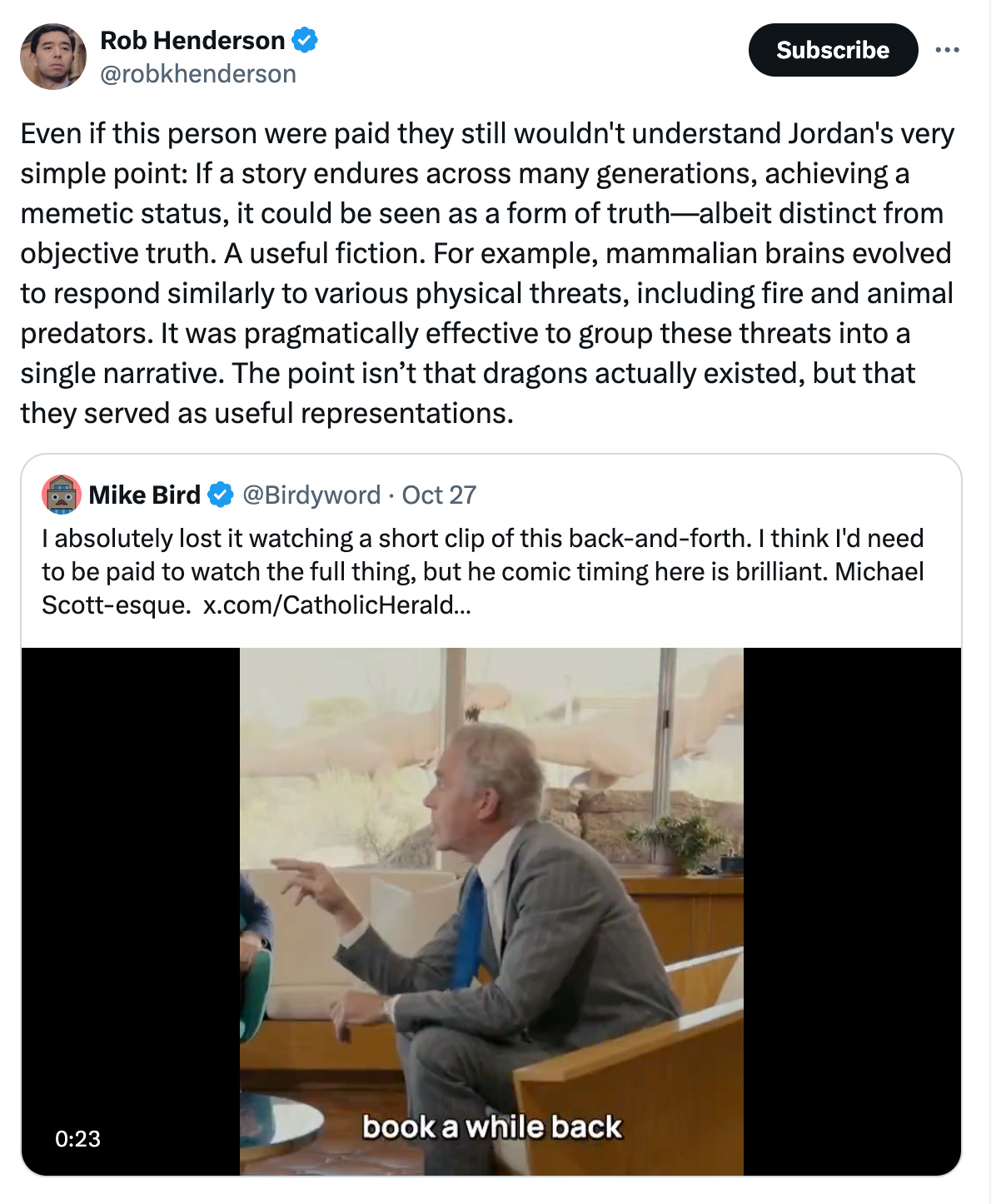In a recent conversation with biologist Richard Dawkins, right-wing pundit and former psychology professor Jordan Peterson says:
So I I spent a fair bit of time studying the psychophysiology of the hypothalamus, okay, so the hypothalamus is set up it's…it's got two halves, basically one half deals with fundamental motivated states [like] hunger, thirst, defensive aggression, sexuality and so forth, and when those areas are dominated the biologically relevant goal is activated and perceptions are oriented towards that goal. Okay, so now…you might ask yourself well what happens if all those biologically motivated states are satiated and the answer seems to be is that the other half of the hypothalamus kicks in and it mediates exploratory behavior and so the default structure of the mammalian nervous system is if satiated or in doubt explore and gather new information.
There's no difference between that and hero mythology. They are the same thing. They're the same thing! The dragon fight for example, which is the oldest story we have, it’s coded in the Mesopotamian mythology, the dragon fight story is explore the dangerous unknown, discover the treasure that revitalizes the community.
There's no difference between that and the science that you practice. They're the same thing.
The moderator, Alex O’Conner, sks Dawkins if he agreed that these are “the same thing.” Dawkins answers slowly, saying he “doesn’t know what to make of” what he just heard. Peterson interjects, “Well, how many dragons have you overcome in your life?”
Share
Dawkins, famously a bit impatient with literary metaphors, answers, “I’m not interested in dragons. I’m interested in reality.”
Peterson responds that he “read a book a while back” that describes “the biological reality of the dragon.”
Okay so I read a book a while back that describes…the…uh…the biological reality of the dragon. Say, well there's no such thing as a dragon. It's like, okay, is there such a thing as a predator? [Dawkins: “Of course.”] Well, that's that's a meta-category! What's the category of predator? Bear. Eagle if you're a primate. Fire? Is fire a predator? [Dawkins: “No.”] Well, it's complicated because a fire kills you! Okay so is there a worse predator than serpentine flying fire breathing-reptile? Is that not the imagistic equivalent of Predator’? So, in what way, if Predator is real, in what way isn't Dragon real? Doesn't take that much imagination to to see the identity…
Peterson posted this clip to his Logos University channel with the title, “Imagine Convincing A Biologist That Dragons Exist.” I have to say that at the end of the clip, Dawkins doesn’t seem particularly convinced.
If we can understand how Eastern Europe can exist with Doctor Doom’s homeland of Latveria existing, we should be able to understand how the general category of predators can exist without this particular imaginary predator existing. Or so I would think!
Peterson’s many admirers did what they could to present the pronouncements quoted above as expressions of deep wisdom.
For example:
It’s a “form of truth,” you see. Just a form other than “objective truth.”
All clear?
If not, try this on for size:
Since “ontology” is the branch of metaphysics that examines the question of which kinds of objects exist, I have no idea what an “ontological object” (as opposed to any other sort of object) might be. But it did occur to me, reading these defenses, that Peterson and his fans (and for that matter Richard Dawkins, who seemed unsure what to say about all this) could benefit from reading Quine.
Willard Van Orman (usually just “W.V.O.”) Quine is probably the most important philosopher in the subcategory “twentieth-century philosophers that very few non-philosophers know about.” How accessible he is heavily depends on what you’re reading. Sometimes, as in his book Word and Object, his prose can get a bit obscure. When he’s writing in a different mode, though, he can be a pleasure to read.
Take his 1948 paper on ontology, “On What There Is.” The first paragraphs let us know that, while he’s going to be delving into abstract questions, he’s going to do so in a fairly light-hearted way:
A curious thing about the ontological problem is its simplicity. It can be put in three Anglo-Saxon monosyllables: ‘What is there?’ It can be answered, moreover, in a word— ‘Everything’—and everyone will accept this answer as true. However, this is merely to say that there is what there is. There remains room for disagreement over cases; and so the issue has stayed alive down the centuries.
Suppose now that two philosophers, McX and I, differ over ontology. Suppose McX maintains there is something which I maintain there is not. McX can, quite consistently with his own point of view, describe our difference of opinion by saying that I refuse to recognize certain entities. I should protest, of course, that he is wrong in his formulation of our disagreement, for I maintain that there are no entities, of the kind which he alleges, for me to recognize…
McX, as the essay develops, is presented as a playful and probably somewhat caricatured stand-in for Alexius Meinong, an Austrian philosopher best remembered for an odd view of ontology according to which in some sense “there are” objects that have all sorts of other properties but lack the property of existence. Much of Quine’s own perspective in “On What There Is” is taken from Bertrand Russell, who firmly rejected the notion of a “non-existent object.”
This disagreement becomes easier to understand if you channel the metaphysics through the philosophy of language. Meinong, as I understand him, thought that a sentence like “dragons don’t exist” refers to a class of non-existent entities, dragons. Russell (and Quine, following his lead) thought it referred to everything that exists, that the logical structure of the sentence, once we drill beneath the surface syntax, is something like:
Of all the things that exist, none of them match the description ‘serpentine flying fire breathing-reptile.’
Whoever was right about the philosophy of language half of the dispute, what interests me here is a move Quine imagines McX making to defend the “being” of various imaginary objects (despite such objects lacking the special property of existence) which sounds to me an awful lot like what Peterson and his fans are coming up with on the Dragon Question.
This is the old Platonic riddle of nonbeing. Nonbeing must in some sense be, otherwise what is it that there is not?
…It is some such line of thought that leads philosophers like McX to impute being where they might otherwise be quite content to recognize that there is nothing. Thus, take Pegasus. If Pegasus were not, McX argues, we should not be talking about anything when we use the word; therefore it would be nonsense to say even that Pegasus is not. Thinking to show thus that the denial of Pegasus cannot be coherently maintained, he concludes that Pegasus is.
McX cannot, indeed, quite persuade himself that any region of space-time, near or remote, contains a flying horse of flesh and blood. Pressed for further details on Pegasus, then, he says that Pegasus is an idea in men’s minds. Here, however, a confusion begins to be apparent. We may for the sake of argument concede that there is an entity…which is the mental Pegasus-idea; but this mental entity is not what people are talking about when they deny Pegasus.
And this is really the nub of the issue. When Richard Dawkins, or any random person on the street, says “I don’t think dragons are real,” he’s obviously not conveying “I don’t think thoughts about dragons in human minds are real” or “I don’t think stories about dragons are real” or “I don’t think the psychological needs filled by such stories are interesting to think about.” They’re denying that dragons exist.
Subscribe now
In fact, if Peterson had said “of course, dragons aren’t real, but I have many fascinating thoughts about where the idea of dragons comes from,” I expect Dawkins might have said, “Fair enough.” I certainly would. But that’s not exciting. “I think evolutionary psychology sheds light on the origin of stories about dragons” is perhaps mildly interesting. “I believe in ‘the biological reality of dragons’” turns heads.
But in order to bring us along for that ride, Peterson has to pass off “the concept of ‘dragon’ comes from our fear of things that really do exist” as “dragons exist,” which just adds an ultimately evolutionary/psychological flourish to the more basic confusion of “the concept of a dragon exists” (true!) with “dragons themselves exist” (false!). And his fans are left to stumble around talking about “ontological objects” and forms of truth which differ from objective truth.
Quine:
McX never confuses the Parthenon with the Parthenon-idea. The Parthenon is physical; the Parthenon-idea is mental… The Parthenon is visible; the Parthenon-idea is invisible. We cannot easily imagine two things more unlike, and less liable to confusion, than the Parthenon and the Parthenon-idea. But when we shift from the Parthenon to Pegasus, the confusion sets in—for no other reason than that McX would sooner be deceived by the crudest and most flagrant counterfeit than grant the nonbeing of Pegasus.
Honestly, now that Peterson has left academia and found employment at the Daily Wire, an outfit that entirely exists to wage culture war and advocate for cruel and reactionary political positions, what I’ve been harping on here is probably the least objectionable aspect of his entire schtick. Hell, it’s fun. Perhaps we should just let the man have his dragons.
On the other hand, the tenth rule in his mega-bestselling 12 Rules for Life is, “Be precise in your speech.” Given that he’s sold enough copies of that book to fill a swimming pool with gold coins like Scrooge McDuck, it really doesn’t seem like too much to ask that he should make some kind of effort to follow those rules. Or at least more of an effort than this.


